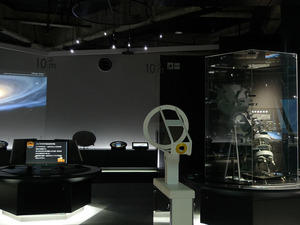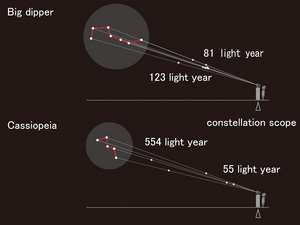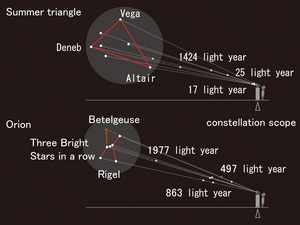Nagoya City Science Museum
TOP > Exhibition Guide > Keyword Search > Starting with "S" > Summer Triangle > Constellations
Constellations



Purpose of Exhibition
Have you noticed the bright stars hanging here and there in this gallery? These are the fixed stars that form the Big Dipper, Cassiopeia, Orion and the Summer Triangle. However, you cannot find the constellations by simply looking up from below.
There are four scopes (round peer holes) in the room, each for observing each constellation. When you look through one of the scopes, you will see the figure of the constellation as you know. This is the same position as we view it from our solar system.
This exhibit will show you that the stars that form a constellation are in fact arranged quite differently when you were to look at them from another position in the Universe, and that the stars in a constellation are not all in the same place, but their distances from the earth are actually quite varied.
Additional Knowledge
[Distance and Brightness]
Even stars of the same brightness appear fainter if they are farther away from the earth, and brighter if closer. In order to compare the original brightness, we need to convert it to how bright they would be when they were placed at the same distance. This brightness for comparison is called “absolute magnitude,” while the brightness we see in the night sky is called “visual magnitude.” We set the hypothetical distance for absolute magnitude at 32.6 light-years, which may seem like a bit of indifferent number, but is actually significant to astronomers.
Stars are very far away, and means to estimate the distance are limited. Using 300 million km as a baseline, the diameter that the earth makes in six months as it orbits the sun, we can measure the apparent change in the position of a star (Angle: θ in the figure). It is at a distance of 3.26 light years that this angle is 1" (second angle: 1/3600 of a degree). However, the closest star to the earth, Alpha Centauri, is 4.3 light years away; 3.26 is too close for a reference. So, we decided on 32.6 light years, which is 10 times the distance of exactly 1".
Incidentally, the absolute magnitude of our sun is 5. If the sun were at a distance of 32.6 light years, it would be quite a modest star in the night sky.
This page was last edited on 30 June 2022.
Article by Astronomy Section
